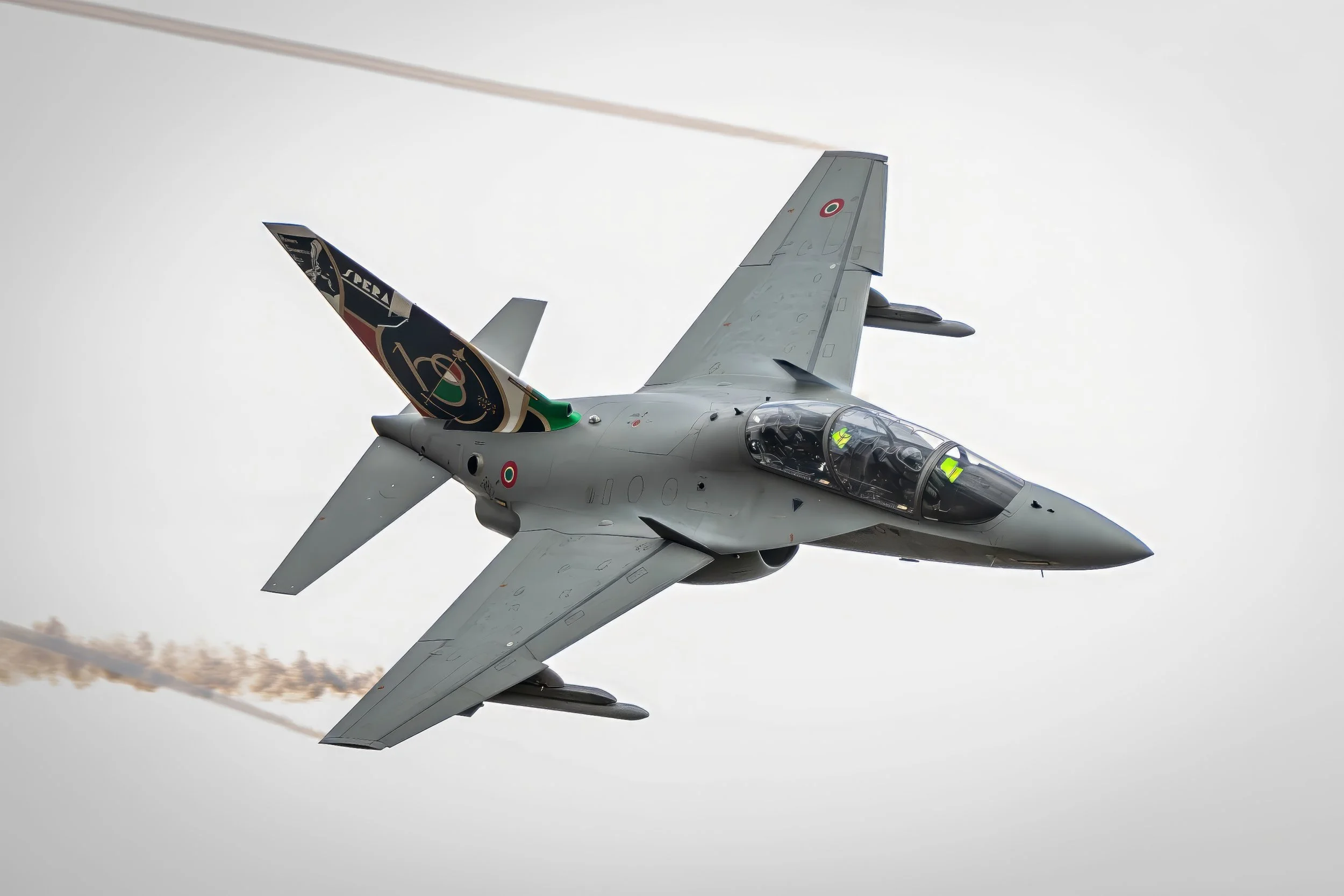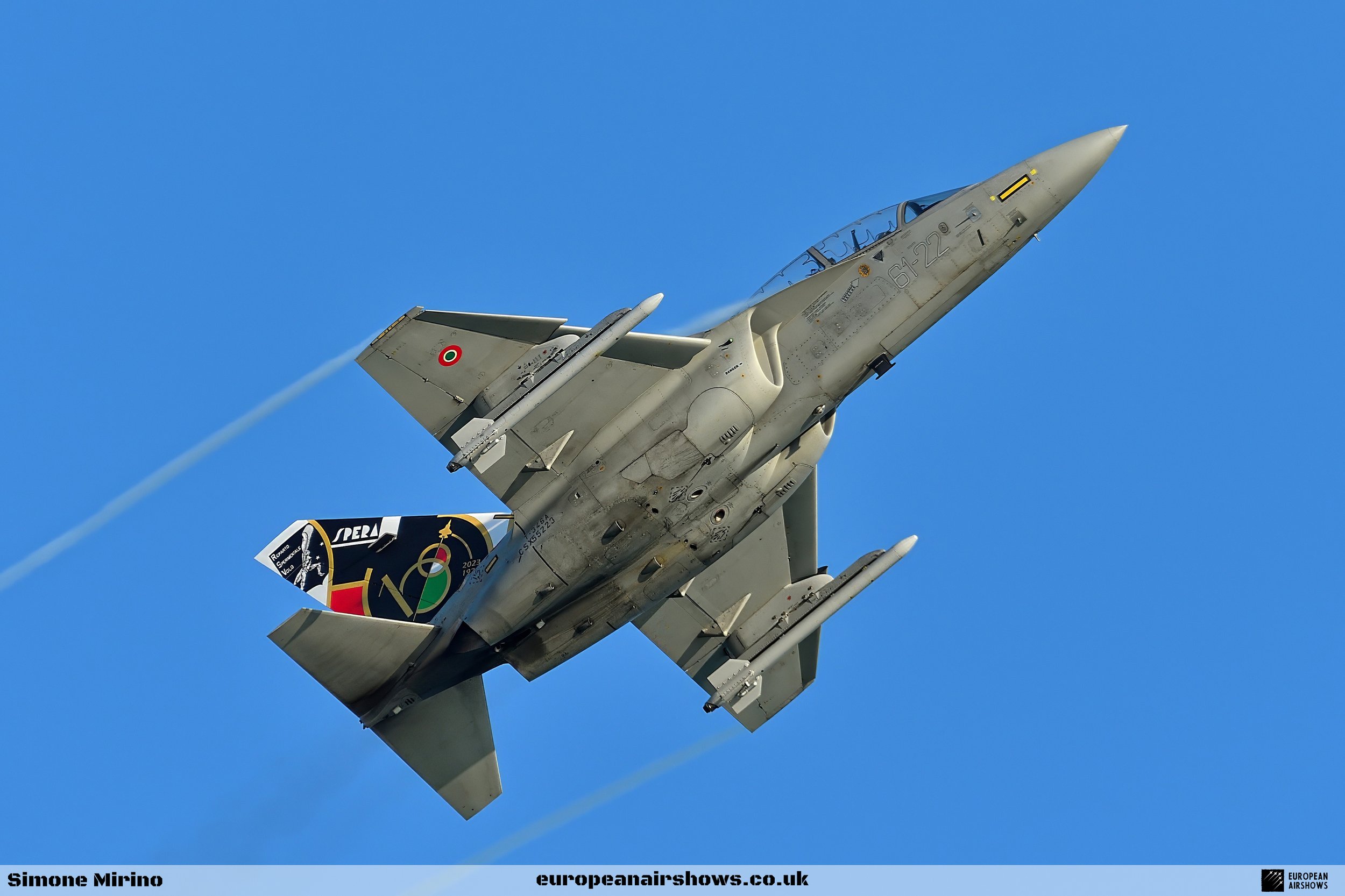
July 15 / Leonardo M-346 Master first flight
First Flight 15 July 2004
Leonardo M-346 Master
The Leonardo M-346 Master is a family of military twin-engine transonic advanced jet trainers and light combat aircraft. Originally co-developed with Yakovlev as the Yak/AEM-130, the partnership was dissolved in 2000 and then Alenia Aermacchi proceeded to separately develop the M-346 Master, while Yakolev continued work on the Yakovlev Yak-130. The first flight of the M-346 was performed in 2004. The type is currently operated by the air forces of Italy, Israel, Singapore, Greece, Turkmenistan and Poland. Since 2016 the manufacturer became Leonardo-Finmeccanica as Alenia Aermacchi merged into the new Finmeccanica, finally rebranded as Leonardo in 2017.
In 1992, Aermacchi signed a cooperation agreement with Yakovlev to provide financial and technical support for the new trainer that the firm had been developing since 1991 for the Russian Air Force in competition with the Mikoyan MiG-AT. Aermacchi also gained the right to modify and market the aircraft for the Western market. The resulting aircraft first flew in 1996 and was brought to Italy the following year to replace the ageing MB-339. By this point, the aircraft was being marketed as the Yak/AEM-130. In February 1996, Russia provided initial funding for the Yak/AEM-130 and pledged to purchase up to 200 aircraft for the Russian Air Force.
In October 1998, it was reported that the venture was increasingly becoming an Italian-led effort due to a lack of financial support on the part of Russia. By July 2000, Aermacchi held a 50% stake in the development programme, and Yakovlev and Sokol had a 25% share each. In mid-2000, it was announced that differences in priorities between the two firms, and a lack of financial backing from the programme's Russian participants, had brought about an end to the partnership and that each firm would pursue the development of the aircraft independently; Yakovlev received US$77 million for technical documents of the aircraft. Yakovlev would be able to sell the Yak-130 to countries such as those in the Commonwealth of Independent States, India, Slovakia and Algeria, while Aermacchi would be able to sell the M-346 to NATO countries, among others.
The M-346 is a highly modified version of the aircraft that was being developed under the joint venture. It uses equipment exclusively from Western manufacturers, such as the digital flight control system being developed by a collaboration between Teleavio, Marconi Italiana and BAE Systems. In July 2000, Aermacchi selected the Honeywell F124 turbofan engine to power the type in place of the originally intended Lotarev DV-2S powerplant. In 2004, a contract for the development of a full-mission simulator for the M-346 was awarded to CAE. Further production contracts for CAE's full-mission simulator have since been issued.
On 7 June 2003, the first M-346 prototype rolled out; ground testing commenced shortly thereafter. On 15 July 2004, the first prototype conducted its maiden flight.
In January 2005, the Greek Ministry of Defence signed a Memorandum of Understanding (MOU) to become a partner in the programme, followed by an industrial cooperation agreement between Aermacchi and the Hellenic Aerospace Industry in 2006. In March 2008, the Chilean ENAER signed a Memorandum of Understanding (MOU) with Alenia Aermacchi at the FIDAE air show.
On 10 April 2008, the first Low Rate Initial Production (LRIP-00) aircraft, produced in the final configuration (new landing gear and air brake, more composite parts), was rolled out. On 18 December 2008, Aermacchi announced that the M-346 had attained a maximum speed of Mach 1.15 (1,255 km/h, 678 knots, 780 mph), claiming the occasion to be the first in which an all-Italian-built aircraft had broken the sound barrier in 50 years.
In May 2008, Boeing signed a Memorandum of Understanding to cooperate on the marketing, sales, training and support of two Aermacchi trainer aircraft, the M-346 and the M-311.
On 20 June 2011, a Military Type Certification was granted to Alenia Aermacchi for the M-346 Master by the General Directorate for Aeronautical Armaments of the Italian Ministry of Defence in Rome. Throughout the certification process, the M-346 development aircraft made 180 test flights, totalling 200 flights across the course of the previous five months, during which over 3,300 test points were completed.
M-346 Master Facts
Advanced Jet Trainer: The M-346 Master is designed primarily as an advanced jet trainer for military pilots. It is used to bridge the gap between basic training aircraft and frontline combat jets, preparing pilots for the complexities of modern air combat.
International Collaboration: The M-346’s design is based on the Yakovlev Yak-130, a joint development project between the Italian company Aermacchi and the Russian company Yakovlev. Although the partnership eventually dissolved, the M-346 and Yak-130 share many design elements.
First Flight: The M-346 made its maiden flight on July 15, 2004. It demonstrated excellent performance and handling characteristics, leading to its adoption by several air forces around the world.
High Performance: The M-346 is powered by two Honeywell F124-GA-200 turbofan engines, which provide it with a high thrust-to-weight ratio. This enables the aircraft to achieve speeds of up to Mach 1.2 and perform advanced aerobatic manoeuvres.
Digital Avionics: The M-346 features a state-of-the-art digital avionics suite, including a glass cockpit with three large multifunction displays, a head-up display (HUD), and hands-on-throttle-and-stick (HOTAS) controls. These systems provide pilots with a modern and intuitive interface, similar to that of frontline combat aircraft.
Simulated Combat Training: One of the key features of the M-346 is its ability to simulate various combat scenarios. The aircraft is equipped with an embedded tactical training system (ETTS) that allows pilots to practice air-to-air and air-to-ground missions in a highly realistic environment.
Export Success: The M-346 has been successfully exported to several countries, including Italy, Israel, Singapore, Poland, and Qatar. These nations use the aircraft to train their next generation of fighter pilots.
Light Attack Capability: In addition to its training role, the M-346 can be configured for light attack missions. It can carry a variety of air-to-air and air-to-ground munitions, including guided bombs, rockets, and missiles, making it a versatile platform for both training and operational missions.
Aerodynamic Design: The M-346 features an advanced aerodynamic design, including a high wing configuration, leading-edge extensions (LEX), and a twin-tail layout. These features contribute to its excellent manoeuvrability and stability at both high and low speeds.
Future Developments: Leonardo continues to develop and upgrade the M-346 platform. Recent variants include the M-346FA (Fighter Attack), which is optimized for light attack and reconnaissance missions, and the M-346FT (Fighter Trainer), which combines advanced training capabilities with operational flexibility.













